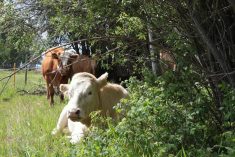We can always pick up ways to improve our cattle operations.
One method is to ask lots of questions of the right people. Another is reading and investigating specific topics.
And an increasingly popular way is to watch instructive videos. The issue here is making sure the source is ethical, reliable and not sensationalized.
A good source of self-help videos is the Beef Cattle Research Council.
We have all had calves that fail to breathe on delivery. One of the council’s very informative videos shows how to place the legs and what to do. It also explains why you should not hang them over the fence as that is counterproductive to survival. Straw up the nose, cold water in the ear, a source of oxygen and there is even an acupuncture point in the middle of the nose that may have merit. The tried-and-proven points are on the video.
Read Also

Grazing ‘sweet spot’ boosts pasture performance
Timing-focused approach to pasture management touted to boost forage growth, livestock gains while also cutting farmer labour and inputs
We all use a tube feeder in many ways to rehydrate calves or give them colostrum or milk replacer. If you are afraid of killing a calf when tubing it, then watch the Calf 911 video on this topic. It will make you rest easy. (And really with the large ball on the end of the feeder, it is almost impossible to get in the wrong place unless the calf is moribund and gasping for air. So the calf you thought you might have killed was most likely very close to death.)
With calves that are dehydrated from either scours or being sick and not sucking, it is very important to recognize this and the degree to determine how much fluids they need. The best place to check is a skin tent or if more severe, the eyes sunken into the eye sockets.
There is also a video on how to determine dehydration. Calves may be acidotic from impending scours and walk with a drunken stupor (and be unable to rise in severe cases). These calves need bicarbonate in an electrolyte solution to reverse the acidosis and a short video of a calf walking like this would be very educational to everyone (including experienced producers) as it is not common to see.
We can never talk too much about colostrum and a video with animation shows how on a tubed calf the rumen fills first and then spills over — which is different than when a calf sucks colostrum from mom or a bottle.
The increased use of the colostrum replacements have their place but there is nothing like the mother’s colostrum. Because of the spillover effect, tubing with 1.5 litres of colostrum (even when more dilute) is better than one litre that is more concentrated. Everyone thinks this amount may make them less hungry to suckle but that definitely does not seem to be the case. If there is slow nursing or to get up, calves from a hard pull, twins (and any others you are concerned about), give them colostrum. And the quicker the better — that is never a wrong move.
So you should watch a brand new Calf 911 video called “How to handle colostrum so newborn calves thrive.” You can find them at beefresearch.ca (click on Resources and then Videos) or by Googling ‘calf 911.’
Even the experienced cattleman or veterinarian can get something from these videos. Grab the popcorn, and give them a second viewing if need be.
The council also has recordings of webinars. I recommend the one on reducing disease in newborn calves through things such as vaccination or using lots of bedding in creep areas. Almost all the speakers on the recorded videos are Canadian, so they know the local conditions and are experts in their field.
In the Resources>Webinars section, you’ll find a large number of these recordings.
Have you ever had reproductive failure where open-rate abortions and retained placentas were high? A webinar recording called “Reproductive failure in the beef herd” features three veterinarians talking about testing and how to rule out diseases to come up with a firm diagnosis. Reproduction is often a ‘next year’ disease and with a firm diagnosis steps can be undertaken to prevent reoccurrence next year.
We all know there has been an increase in lice issues these past few years, so it was a good idea to develop a webinar with some of Canada’s experts on treatments and the issues with resistance and strategies to keep fly and lice problems under control (our two main issues when it comes to external parasites). We need to get timing right as well as look at what products are currently effective. They keep limiting the pesticides we can use but ask your veterinarian about new ones on the market and also the best methods for application and time to administer.
Articles on animal health, record-keeping, forage production and even the interface with wildlife — it can all be found within the confines of the BCRC website. I am no computer guy but even I can navigate this website quite easily and quickly to get quality information to help me make decisions today.
Have a great spring calving everybody. We are all in this together.
















